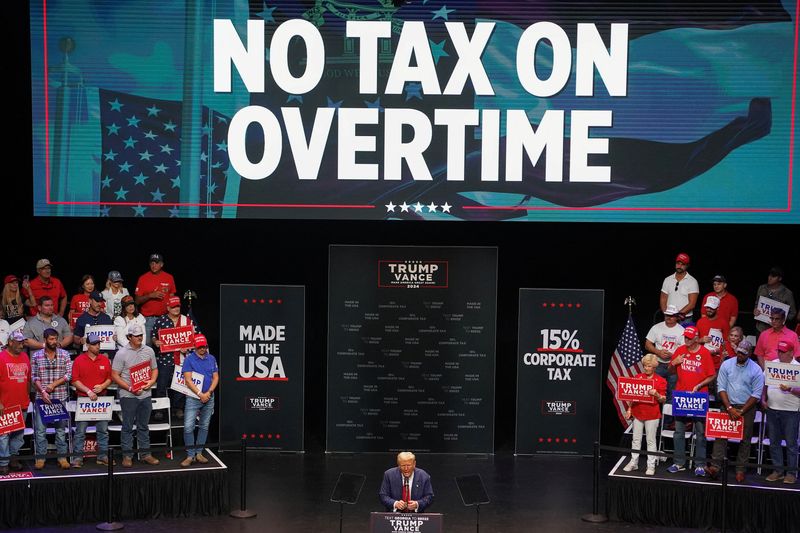By Helen Coster
(Reuters) -Republican presidential candidate Donald Trump has made tariffs and tax cuts the key elements of his economic pitch to voters, the majority of whom view the economy as the biggest campaign issue of the 2024 presidential election.
Several prominent budget forecasters have estimated Trump's tax cut plans would add some $3.6 trillion to $6.6 trillion to federal deficits over a decade, depending on which proposals are included. The same forecasters show Democratic candidate Kamala Harris' spending and tax-break plans would add far less to deficits and possibly may reduce them, with a range of a $400 billion reduction over a decade to a $1.4 trillion increase, depending on which proposals are included.
Here are the tariff and tax proposals Trump has made so far in his campaign:
TARIFFS ON IMPORTS
The former president has floated plans for blanket tariffs of 10% to 20% on virtually all imports, as well as tariffs of 60% or more on goods from China, in a bid to boost U.S. manufacturing.
On Sept. 23, Trump said he would slap a 200% tariff on John Deere (NYSE:DE)'s imports into the U.S. if the company moved production to Mexico as planned, comments that hit the agricultural equipment manufacturer's share price.
Trump has frequently said he would hit automakers that move their production to Mexico with a 200% tariff, but his Sept. 23 remarks appeared to be the first time he had extended that threat to an agricultural equipment company. The duties would likely violate the U.S.-Mexico-Canada Agreement on trade that he signed into law in 2020.
During an Oct. 10 speech in Detroit, Trump said he would put tariffs as high as 200% on every car coming across the U.S.-Mexico border. He also has said he would reward U.S.-based manufacturers with research and development tax credits.
The National Retail Federation, which represents Walmart (NYSE:WMT) and other companies that account for almost half of container shipping volume, is among the industry groups opposed to Trump's proposed tariffs. Economists say tariffs would reignite inflation.
A narrow majority of U.S. voters support Trump’s campaign vow to increase tariffs on imported goods, particularly from China, according to a Sept. 11-12 Reuters/Ipsos poll.
In the Detroit speech, Trump said if he becomes president, he will formally notify Mexico and Canada of his intent to renegotiate a North American free trade deal to address concerns about Chinese vehicles.
TAX CUTS FOR DOMESTIC PRODUCERS
In early September, Trump pledged to reduce the corporate tax rate from 21% to 15% for companies that make their products in the U.S.
While he had previously said he wanted to cut the corporate tax rate to 15%, he had not tied that lower rate to keeping manufacturing inside the country.
Trump slashed the corporate tax rate to 21% from 35% during his 2017-2021 presidency.
NO TAX ON OVERTIME PAY, TIPS OR SOCIAL SECURITY INCOME
Trump said on Sept. 12 that, if he is elected, he will end all taxes on overtime pay as part of a wider tax cut package.
Trump has also said he would seek legislation to end the taxation of tips. Harris has made a similar pledge. Current law requires employees to report their tips as taxable income.
Trump has also vowed to exempt Social Security income from taxes.
EXTEND TAX CUTS
Trump wants to extend all individual tax cuts he pushed through Congress in 2017, including for the wealthiest Americans, which tax and budget experts estimate would reduce revenue over a decade by about $3.3 trillion to $4 trillion.
END 'DOUBLE TAXATION' ON U.S. CITIZENS OVERSEAS
Trump has pledged to lower taxes on U.S. citizens living abroad without providing specifics. Americans living or traveling outside the U.S. are required to file income tax returns, estate tax returns, and gift tax returns and "pay estimated tax in the same way as those residing in the United States," according to the U.S. Internal Revenue Service.
UNCLEAR PROPOSAL ON 'SALT' DEDUCTION
In a Sept. 17 Truth Social post, Trump vowed to “get SALT back” – a reference to the state and local tax (SALT) deduction available to federal taxpayers. At a rally the next day, Trump said he would be “restoring the SALT deduction” if reelected. Trump’s 2017 tax cuts imposed a $10,000 cap on the amount of state and local tax that taxpayers can deduct. It was unclear whether Trump was suggesting he would remove the $10,000 cap, which predominantly affects high-tax, Democratic-leaning states such as New York.
DEDUCT COST OF GENERATORS
After Hurricanes Helene and Milton struck the Southeast, Trump said he would allow the cost of home generators purchased in states hit by natural disasters between Sept. 1, 2024, and Aug. 31, 2025, to be tax-deductible.
OTHER ECONOMIC PROPOSALS
Beyond tax cuts and tariffs, Trump has promised he would support the oil and gas industry by backing new pipelines and restoring fracking on federal land in a bid to boost the economy. On Sept. 24, he said he would put Alaska's Arctic National Wildlife Refuge - where the Biden administration canceled oil and gas drilling leases - "back into play" if he wins the election.
He has also said he would consider ending a $7,500 tax credit for electric vehicle purchases. While president, Trump sought to repeal the EV tax credit, which was later expanded by President Joe Biden in 2022.

In his Oct. 10 Detroit speech, Trump said he would propose making interest on car loans tax-deductible.
During a Sept. 18 campaign rally in New York, Trump pledged to put a temporary cap on credit card interest rates of “around 10%.”